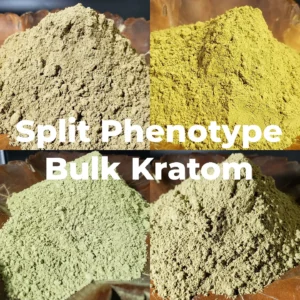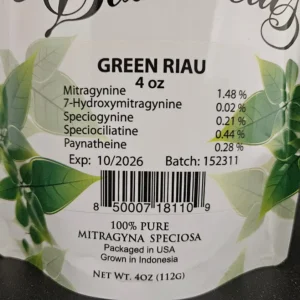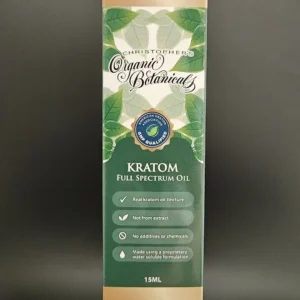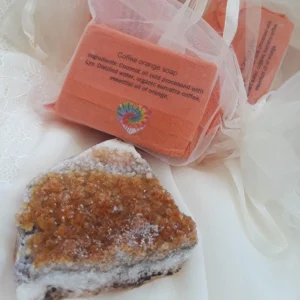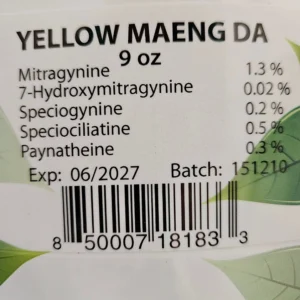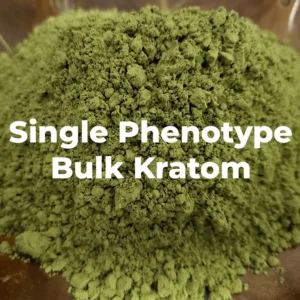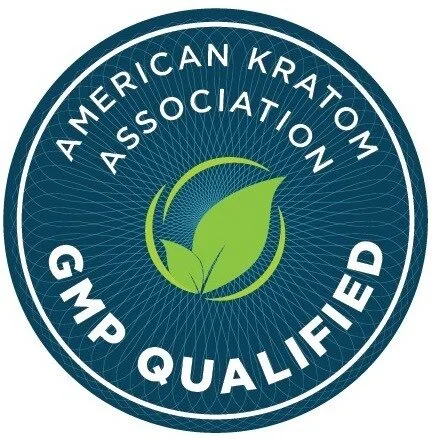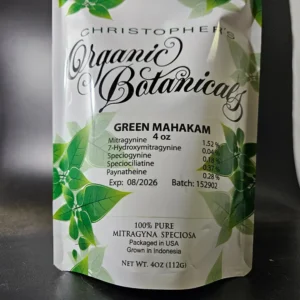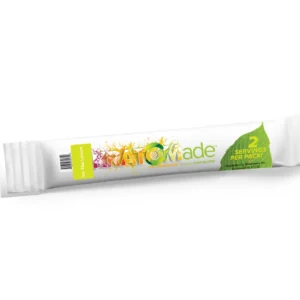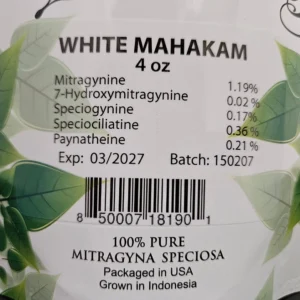Mitragynine is the main alkaloid found in kratom, with concentrations of up to 66%. Other alkaloids present in kratom include speciogynine, speciociliatine, paynantheine, raubasine, and mitraphylline. In addition, a small amount of corynantheidine and other alkaloids are also present.
Listed below are the active ingredients in kratom, which are called alkaloids. The list below contains the Kratom Alkaloids present in the kratom leaf and their corresponding percentages:
Kratom Alkaloids Effects List – Alkaloids in Kratom- Active Ingredients in Kratom
Ajmalicine (Raubasine): Cerebrocirculant, antiaggregant, anti-adrenergic (at alpha 1), sedative, anticonvulsant, smooth muscle relaxer. Also found in Rauwolfia serpentina. Cerebrocirculant, antiaggregant, anti-adrenergic (at alpha 1), sedative, anticonvulsant, smooth muscle relaxer. It is structurally related to alkaloids from yohimbe. Ajmalicine is an α1-adrenergic receptor antagonist with preferential actions over α2-adrenergic receptors, which is the reason for its hypotensive effects.
Akuammigine: An indole alkaloid associated with the seeds of Picralima nitida (akaumma). It is structurally like yohimbine and mitragynine. It has antimalarial activity, similar to yohimbine.
Ciliaphylline: antitussive, analgesic. < 1% of total content found in Kratom leaf.
Corynantheidine: μ -opioid antagonist, also found in Yohimbe. < 1% of total content found in Kratom leaf. μ -opioid antagonist, also found in Yohimbe. Ajmalicine is related to it and it is a diastereomer of yohimbine. Like ajmalicine, it is an α1-adrenergic and α2-adrenergic receptor antagonist with 10x greater affinity for the α1-adrenergic receptor. Yohimbine and its diastereomer, rauwolscine, have a 30x higher affinity for the α2-adrenergic receptor than the α1-adrenergic receptor. This is in contrast to their opposite affinities.
Corynoxeine: Calcium channel blocker. < 1% of total alkaloid content found in Kratom leaf.
Corynoxine A and B: Dopamine mediating anti-locomotives. < 1% of total content found in Kratom leaf. Dopamine mediating anti-locomotives, meaning that they act as somewhat of a sedative. Chinese Cat’s Claw (Uncaria tomentosa) also contains them.
Epicatechin: Antioxidant, antiaggregant, antibacterial, antidiabetic, antihepatitic, anti-inflammatory, anti-leukemic, antimutagenic, antiperoxidant, antiviral, potential cancer preventative, alpha amylase inhibitor. Dark chocolate, green tea, and grapes also contain it.
9-Hydroxycorynantheidine: Partial opioid agonist. A study found that 9-Hydroxycorynantheidine inhibited contraction of the ileum in guinea-pigs. The maximum inhibition of this substance was weaker than that of mitragynine. Naloxone was able to antagonize this effect, showing that 9-Hydroxycorynantheidine has partial agonist properties on opioid receptors.
7-hydroxymitragynine: an analgesic, antitussive, and antidiarrheal. The total content of this compound found in Kratom leaf is minimal. People believe that the concentration in the Kratom leaf itself is extinct. Mitragynine, the primary active alkaloid in Mitragyna speciosa (kratom), is metabolized in mice into 7-hydroxymitragynine, an active metabolite. This metabolite exerts its pain-relieving effects by interacting with the mu-opioid receptor.. 7-Hydroxymitragynine is a metabollite of the kratom leaf.
Isomitraphylline: Immunostimulant, anti-leukemic. Less than 1% of the total content is present in the Kratom leaf.
Isomitrafoline: Less than 1% of the total content is found in the leaf of Kratom.
Isopteropodine: Immunostimulant, antimicrobial.
Isorhynchophylline: Immunostimulant. Less than 1% of the total alkaloid content is present in the Kratom leaf.
Isospeciofoline: Less than 1% of the total alkaloid content is present in the Kratom leaf.
Mitraciliatine: Less than 1% of the total alkaloid content is present in the Kratom leaf.
Mitragynine: Indole alkaloid. Analgesic, antitussive, antidiarrheal, adrenergic, antimalarial, possible psychedelic (5-HT2A) antagonist. Kratom leaf contains roughly 66% of the total alkaloid content.
Mitragynine oxindole B. Less than 1% of the total alkaloid content is present in the Kratom leaf.
Mitrafoline: Less than 1% of the total alkaloid content is present in the Kratom leaf.
Mitraphylline: Oxindole alkaloid. Vasodilator, antihypertensive, muscle relaxer, diuretic, antiamnesic, anti-leukemic, possible immunostimulant. <1% of total alkaloid contents in Kratom leaf.
Mitraversine Found in Mitragyna parvifolia and may also be in Mitragyna speciosa.
Paynantheine: Indole alkaloid. It seems like a smooth muscle relaxer, but there is limited research available and we need to do more. The alkaloid composition in Kratom leaf ranges from 8.6% to 9%.. Second most abundant alkaloid.
Rhynchophylline: Vasodilator, antihypertensive, calcium channel blocker, antiaggregant, anti-inflammatory, antipyretic (fever reducing), antiarrhythmic, and anthelmintic (treatment of parasitic worms). It is also a non-competitive NMDA antagonist and appears to also have effects on dopamine and 5-HT receptors. Chinese Cat’s claw (Uncaria tomentosa) also contains Rhynchophylline. It has a similar chemical structure to mitragynine and represents < 1% of total alkaloid content found in kratom leaf.
Speciociliatine: Weak opioid agonist. Kratom leaf contains a unique content of 0.8% to 1%.
Speciofoline: Potential analgesic and antitussive. Patented (US3324111) by Smith Kline (of Glaxo Smith Kline) in 1964. Also patented (US20100209542) by the University of Massachusetts Medical School and University of Mississippi in 2009 to treat opiate withdrawal. The patent was abandoned as of February 18, 2019.
Speciogynine: Diastereomer of mitragynine. Possible smooth muscle relaxer. 6.6% to 7% of total alkaloid contents of kratom leaf, representing the third most abundant alkaloid.
Speciophylline: Indole alkaloid. Anti-leukemic. Less than 1% of the total alkaloid composition in a Kratom leaf.
Stipulatine: More research needed.
Tetrahydroalstonine: Hypoglycemic, anti-adrenergic (at alpha 2).
Can Boiling Water Destroy Kratom Alkaloids?
Boiling water can potentially degrade some of the alkaloids in Kratom, though the extent of this effect is a topic of debate among users and researchers. Here’s a detailed look at the factors involved:
Kratom Alkaloid Stability
Mitragynine: This is the primary active alkaloid in Kratom and is relatively stable at high temperatures. However, prolonged exposure to boiling temperatures might cause some degradation.
Research and Observations
Temperature Sensitivity: Alkaloids in general can be sensitive to heat, and while Kratom alkaloids are fairly robust, they are not immune to degradation. Studies on other plant alkaloids suggest that exposure to boiling water can cause a reduction in potency due to chemical changes.
User Experiences: Anecdotal evidence from Kratom users indicates that boiling Kratom tea can still be effective, although some users prefer to steep Kratom in hot, but not boiling, water to preserve the alkaloid content.
Practical Recommendations
1. Steeping in Hot Water: To minimize potential alkaloid degradation, it is recommended to steep Kratom in hot water (below boiling point) rather than boiling it for extended periods.
2. Short Boiling Times: If boiling, keeping the boiling time short can help preserve the alkaloid content. Simmering Kratom for 10-15 minutes is a commonly used method.
Conclusion
While boiling water can cause some degradation of Kratom alkaloids, many users still find Kratom tea effective. For optimal preservation of alkaloid content, using hot (but not boiling) water or minimizing boiling time is recommended.
References
For more detailed information, you can refer to sources such as:
PubMed: Stability of Mitragynine (https://pubmed.ncbi.nlm.nih.gov/)
Kratom Science: Effects of Heat on Kratom Alkaloids (https://www.kratomscience.com/)
Kratom Mitragynine Content
The total alkaloid concentration in dried Kratom leaves typically ranges from 0.5% to 1.5%. In Thai varieties, mitragynine is the predominant alkaloid, comprising up to 66% of the total alkaloid content.
Trees harvested during the first growth spurt after a long dry season typically have the highest mitragynine content. This is especially true for frequently harvested trees. This is attributed to a mix of factors.
During the dry season, the leaves’ growth is limited. As a result, mitragynine and other alkaloids accumulate in the leaf. The leaves experience a growth spurt after the first rain, and they deposit these leaves. These leaves can often have a red-ish appearance.
The frequency of harvesting also affects the concentration, particularly mitragynine. Researchers believe that Mitragyna speciosa produces substances called alkaloids, including mitragynine, as a defense mechanism.
This is to prevent animals from eating the leaves. If you do not harvest the leaves, the plant does not waste energy producing the alkaloids. However, if someone frequently removes the leaves, then Mitragyna speciosa produces more to prevent this.
Chelsea Colleges Kratom Alkaloid Studies
Department of Pharmacy/King’s College London Department of Pharmacy
Between 1961 and 1970, they collected thirty samples of Kratom from Thailand, Malaysia, and Papua New Guinea. All contained mitragynine, but also proved to have considerable variation in the makeup. The most common profile for red and green / white leaved plants of Thailand was mitragynine, speciogynine, speciociliatine, and paynantheine. Additionally, there were traces of ajmalicine, (C9) methoxy-oxindoles, and other indoles.
Yet other Thai plants contained distinct profiles, some with many more alkaloids. In the Malay specimens, one contained mitragynine, Speciofoline, and other indoles and oxindoles.
The other specimens contained mitragynine, ajmalicine, speciogynine, speciociliatine, paynantheine, traces of indoles, and (C9) methoxy-oxindoles. Specimens from Papua New Guinea contained mitragynine, speciogynine, speciociliatine, paynantheine, specionoxeine, and isospecionoxeine.
Before the late 1990s, most chemical studies of Kratom focused on 7-hydroxymitragynine. Researchers assumed that 7-hydroxymitragynine was the main active indole alkaloid. Mitragynine has now been identified as the main psychoactive alkaloid in Kratom. 7-hydroxymitragynine is a metablolite of kratom, therefore, many elements of these studies must be revised.
Hiromitsu Takayamas Kratom Alkaloid Discoveries
Hiromitsu Takayama also found that Thai and Malay Kratom had the alkaloids mitragynine, speciogynine, speciociliatine, paynantheine and 7-hydroxymitragynine in common. Mitragynine was the most abundant alkaloid in both Thai and Malay samples.
In the Thai Kratom sample, it made up 66% of the total alkaloids. However, in the Malaysian sample, it only made up 12%. The Malay Kratom sample had mitragynaline and pinoresinol as major components, as well as mitralactonal, mitrasulgynine and 3,4,5,6-tetradehydromitragynine.
In 1986, Peter Houghton and Ikram Said discovered four new indole alkaloids. These alkaloids were corynantheidaline, corynantheidalinic acid, mitragynaline, and mitragynalinic acid. They were found in the young leaves of Malay Mitragyna Kratom plants.
These new alkaloids were found to be more abundant in the Malay Kratom sample than in the Thai sample. In the Malay sample, they accounted for 30% of the alkaloids, but in the Thai sample, they only accounted for 12%.
The Malay Kratom sample contained new alkaloids. This may explain why it had different effects than the Thai Kratom. We need to conduct further research on these new alkaloids to determine their potential therapeutic effects.
Edward Joseph Shellards Work With Kratom Alkaloids
In the 1960s, Professor Shellard achieved global recognition for his work on alkaloids in Mitragyna plants. He was an avid supporter of young scientists. His laboratory fostered an environment that allowed them to excel. Many of these scientists went on to become influential pharmacognosists in places such as Ghana and Thailand.
Shellard’s studies revealed the presence of several alkaloids in Mitragyna Kratom plants, including mitragynine, 7-hydroxymitragynine, mitraphylline, and speciogynine. He also identified several other alkaloids, such as Rhynchophylline, Corynoxeine, Corynoxine, and epicatechin. In addition, he identified several new alkaloids, such as Mitrafoline, Mitrafoline, mitrafolinic acid, and mitragynaline.
Shellard’s work provided a foundation for further research into the pharmacology of Kratom plants. Kratom is now commonly used for its medicinal benefits. It is becoming a popular alternative to traditional treatments for many health issues.
Researchers have discovered a variety of alkaloids in various Kratom samples. Further studies and experimentation are needed to investigate the activity, effects, and potential applications of these alkaloids.
Conclusion
Many secondary chemicals are present in Mitragyna speciosa, but in tiny amounts. Their role in the pharmacology of the plant is not fully understood yet. This is because research has only just begun.
Concentration percentages given come from different studies of alkaloid concentrations in Mitragyna speciosa (Kratom) leaf. Some of the alkaloids given in this list still need to be studied more specifically to determine their potential activity. Further studies are needed to gain insight into the activity, effects, and applications of these alkaloids.
It is evident that Mitragyna speciosa Kratom is much more than a mere mild stimulant. Mitragyna speciosa contains many secondary chemicals. Their role in the plant’s pharmacology is not yet known, as research is still in its early stages.
To understand the alkaloids present in Mitragyna speciosa better, further experimentation and study is needed. This will help determine the concentrations and potential activity of each alkaloid.

